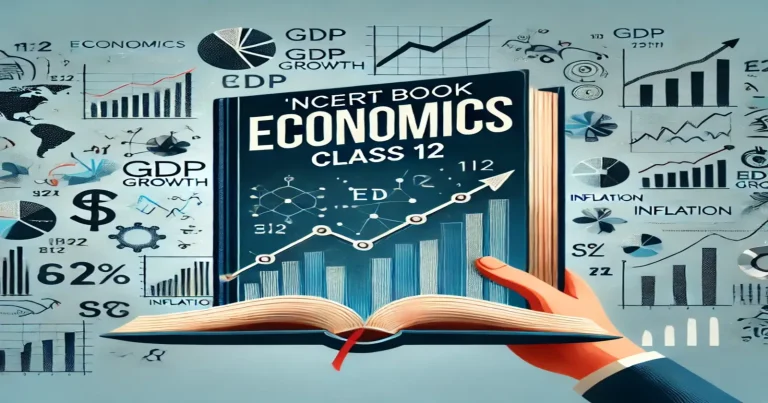The Class 12 Economics Book NCERT is a very important book for Indian students to impart foundational knowledge in both microeconomics and macroeconomics. It is also easy to follow due to easy explanations and structured content. This gives not only a deep understanding of economic principles to the student but also the same has been undertaken concerning the Indian economy.
Economics is the study of production, consumption, and transfer of wealth. Candidates are asked several questions relating to everyday economics or GK-related topics concerning the Indian or Global Economy. Economics Class 12 NCERT book focuses on the actual applications of economic theories. Hence, it is quite a necessity for students to sit for board exams as well as competitive entrance exams.
NCERT Class 12 Economics Book PDF: Download for Free
The NCERT Economics textbook forms the base of economic study at the higher secondary level. If a candidate chooses to opt for Economics as their optional subject, then it becomes important for them to use the material provided in the Class 12 NCERT Economics Books. It is useful for students who are studying the medium of both English and Hindi. Economics class 12 NCERT books give an understanding of the workings of the Indian economy besides looking into various problems along with their solutions in economics. Check out below the download link for Class 12 NCERT Microeconomics and Macroeconomics Book PDF in both languages.
| Download PDF for NCERT Class 12 Economics Book | |
| NCERT Books for Class 12 Introductory Microeconomics in English | Download PDF |
| NCERT Books for Class 12 Introductory Macroeconomics in English | Download PDF |
| NCERT Books for Class 12 Introductory Microeconomics in Hindi | Download PDF |
| NCERT Books for Class 12 Introductory Macroeconomics in Hindi | Download PDF |
NCERT Class 12 Economics Chapters PDF: Download Free
The NCERT Class 12 Economics Chapter PDF presents an all-around introduction to the topic and sets the stage for learning important economic concepts. The chapter touches on important topics, including the nature of economics, the kinds of economic activities, and the fundamental economic problems of societies. It aims to equip students with the knowledge required to analyze how resources are allocated in different economies. By making the chapter PDF available, students will be able to download the material and use it for self-study and revision purposes in preparation for the board exams.
| Download PDF for NCERT Class 12 Economics Chapters (Introductory Microeconomics) | |
| NCERT Economic for Class 12 Chapter 1 | Download PDF |
| NCERT Economic for Class 12 Chapter 2 | Download PDF |
| NCERT Economic for Class 12 Chapter 3 | Download PDF |
| NCERT Economic for Class 12 Chapter 4 | Download PDF |
| NCERT Economic for Class 12 Chapter 5 | Download PDF |
NCERT Class 12 Macroeconomics PDF
NCERT Class 12 Economics (Introductory Macroeconomics) covers topics such as national income, money and banking, fiscal policy, and more. It helps the students understand macroeconomic concepts and their applications in real life.
| Download PDF for NCERT Class 12 Economics Chapters (Introductory Macroeconomics) | |
| NCERT Economic for Class 12 Chapter 1 | Download PDF |
| NCERT Economic for Class 12 Chapter 2 | Download PDF |
| NCERT Economic for Class 12 Chapter 3 | Download PDF |
| NCERT Economic for Class 12 Chapter 4 | Download PDF |
| NCERT Economic for Class 12 Chapter 5 | Download PDF |
| NCERT Economic for Class 12 Chapter 6 | Download PDF |
NCERT Class 12 Economics Book – Microeconomics: Chapter-Wise Details
Enter the world of Microeconomics with the NCERT Class 12 Economics book, specially designed to provide students with an understanding of economic concepts. The textbook provides in-depth chapter-wise descriptions to provide ease of comprehension for intricate subject matter such as market dynamics, theories of production, and consumer behavior. Study each chapter to develop a strong base in Microeconomics, which is essential for academic success and facing future economic challenges.
| Economics Part | Chapter | Title | Key Focus |
| Microeconomics | 1 | Introduction to Microeconomics | Basic concepts, marginal utility, and demand |
| 2 | Theory of Consumer Behaviour | Consumer decisions, market value analysis | |
| 3 | Products & Costs | Pricing, production costs, cost calculations | |
| 4 | Theory of the Firm Under Perfect Competition | Revenues, profits, market dynamics | |
| 5 | Market Equilibrium | Equilibrium, price mechanisms, market forces | |
| 6 | Non-competitive Markets | Monopolies, market dominance, pricing influence | |
| Macroeconomics | 1 | Introduction to Macroeconomics | Aggregate concepts, national scope, basic economic measures |
| 2 | National Income Accounting | Economic indicators, GDP, GNP, national income methods | |
| 3 | Money and Banking | Monetary systems, role of banks, supply and demand of money | |
| 4 | Determination of Income and Employment | Aggregate demand, economic components, calculations | |
| 5 | Government Budget and Economy | Fiscal policies, budget types, economic impact | |
| 6 | Open-Economy Macroeconomics | International trade, balance of payments, exchange rates |
Chapter 1 – Introduction to Microeconomics
Microeconomics, which is more specific than macroeconomics, examines the decisions of managers and individuals in an economic scenario. The chapter explains how businesses, families, and individuals function economically and set their priorities. The NCERT Class 12 Microeconomics textbook simplifies complex concepts such as marginal utility and demand and makes them easy to grasp and understand.
The clear-cut presentation in the NCERT Economics Class 12 textbook makes it a great book for students who want to gain a better understanding of the subject. Students also have the choice to download the PDF book so that they can study more easily.
Chapter 2 – Theory of Consumer Behavior
In this chapter, students learn why consumers purchase products. The chapter guides students on how to analyze the market value of goods and predict their chances of success in a competitive market. With the NCERT Class 12 Microeconomics PDF download, students can comprehensively study how consumer behavior is affected by variables such as personal taste, budget constraints, and income levels.
The concepts are defined by giving a lot of examples so that the students find it simple to learn about consumer behavior and apply it to real-life situations. The questions given as exercise also induce critical thinking where students have to reply to challenging questions and create profound understanding.
Chapter 3 – Products & Costs
This chapter discusses determining firms’ selling prices for their goods after production. It entails considering different production costs, such as the functions of various products and their overall role, as well as expenses, such as total, fixed, and variable costs. NCERT Indian Economic Development books for Class 12 guide you to learn how to define and compute these costs accordingly.
The chapter also discusses laws of variable proportions diminishing marginal product, and so on. These sections facilitate students fully understanding how price is determined and what inputs are taken for such calculations.
Chapter 4 – Theory of the Firm Under Perfect Competition
The chapter discusses important terms such as revenues, profit, break even point, supply curve, and elasticity of supply that are used to examine the economic position of a firm. It also educates students on identifying a firm in a perfectly competitive market where the demand and supply meet at a steady price.
By reading the NCERT Indian Economy Class 12 book properly, students can understand these points better. Material is provided simply so that students can read topics easily without wasting too much time.
Chapter 5 – Market Equilibrium
This chapter explains in detail what market equilibrium is and the determinants of market equilibrium. Important terms like excess demand, equilibrium quantity, equilibrium price, price floor, and price ceiling are defined clearly to enable students to grasp these crucial concepts easily.
The NCERT Class 12 Economics book PDF provides students with a better insight into market equilibrium and how it occurs. Students can read through the chapter, learn about the nuances of market dynamics, and implement that to solve the exercise questions presented at the end of the chapter.
Chapter 6 – Non-competitive Markets
The chapter introduces students to the theory of non-competitive markets and their important effects. In such markets, one brand or agent may control completely, having the ability to directly or indirectly influence product prices. The NCERT Class 12 Indian Economic Development book offers a balanced perspective to enable students to understand the dynamics of non-competitive markets. The chapter also teaches students how these markets operate and the possible impacts they can have on the economy.
NCERT Class 12 Economics Book – Macroeconomics: Chapter- Wise Details
Step into the comprehensive world of Macroeconomics using the NCERT Class 12 Economics book that provides in-depth analysis of larger economic activities and policies. This section contains a detailed chapter-wise analysis of important subjects like national income, money and banking, and economic growth. The chapters aim to improve students’ understanding of the global economic system and processes.
Chapter 1 – Introduction to Macroeconomics
Macroeconomics studies the economy at large, considering the economic variables of a whole system, e.g., a country. This is the introductory chapter in the NCERT Class 12 Macroeconomics textbook, and it encompasses a variety of financial topics ranging from national income to aggregate investment, aggregate employment, aggregate consumption, and general price level.
Chapter 2 – National Income Accounting
The second chapter of the NCERT Class 12 Macroeconomics textbook explores the idea of national income accounting. National Income Accounting is a system that gauges and computes the economic progress of a country over a year of government accounts. GNP, GDP, and GNI are also described and how they are calculated.
This chapter determines the importance of these measures in ascertaining the economic prosperity of a nation. It outlines how they are estimated via the income, expenditure, and product approaches. These are very important fundamentals to understand the impact of economic policy on total growth.
Chapter 3 – Money and Banking
The chapter discusses the equilibrium between the demand for and supply of money, beginning with a functional definition. The chapter discusses the measurement of money in terms of currency and delves into the critical role banks play in an economy. With the NCERT Class 12 Macroeconomics PDF, you will be introduced to how financial institutions and aids in the economic system of a country create money.
The NCERT book aims to explain such concepts in clear terms so that one can understand how a bank works and how the equilibrium between money demand and money supply is achieved in the economy.
Chapter 4 – Determination of Income and Employment
This chapter discusses the idea of aggregate demand and its constituents, including consumption and investment. It defines these terms and educates students on how to compute them through certain formulas. Through the NCERT Class 12 Macroeconomics books, you can learn important details and conditions required for these computations.
Also, the problems at the end of the chapter give one a glimpse into the questions that appear on exams. These problems practice you for harder questions, as well as further your understanding and application skills based on practice that is available within the downloadable PDF of NCERT Class 12 Economics.
Chapter 5 – Government Budget and Economy
Government budget is one concept that falls under scholarly research and the knowledge of any average person. It is the statement of approximated revenues and department spending during a fiscal year. Understanding how approximations are estimated is important as it greatly affects a country’s economy, such as interest rates and the stock exchange.
You can download the Macroeconomics NCERT PDF from our website to learn about various budgets, such as deficit, surplus and balanced budgets. The exercise questions are provided at the end of the chapter to test and reinforce your knowledge about the same.
Chapter 6 – Open-Economy Macroeconomics
Chapter 6 deals with the dynamics of an open economy, where foreign trade is extended to international markets. The chapter deals with major topics like the balance of payments, exchange rate systems, and their advantages and disadvantages. The students will develop a macro-level view of how international trades are carried out.
Students can understand these ideas thoroughly by going through the NCERT Class 12 Macroeconomics PDF. The exercises in the chapter also offer a platform to practice related problems, improving their skills and results.
Economics Class 12 NCERT Books FAQs
What is the focus of the Indian Economic Development Class 12 NCERT Book?
The Indian Economic Development Class 12 NCERT Book emphasizes the Indian economy, discussing its history, key sectors, economic challenges, and development strategies, making it ideal for understanding economic principles applied to India.
What is covered in the Class 12 Microeconomics Book?
The Class 12 Microeconomics Book includes individual economic units’ behavior, such as households and firms, discussing demand-supply analysis, production, cost, and revenue concepts, which are fundamental in understanding market dynamics.
Is the Class 12 Economics NCERT Book available in Hindi?
Yes, the Class 12 Economics NCERT Book in Hindi is available, offering the same curriculum for Hindi-medium students. It includes both microeconomics and macroeconomics sections, ensuring language accessibility for all learners.
How does the Class 12 Macroeconomics Book differ from Microeconomics?
While microeconomics focuses on individual units, the Class 12 Macroeconomics Book covers broader economic indicators, such as national income, inflation, and fiscal policies, providing a comprehensive look at the economy’s aggregate behavior.


